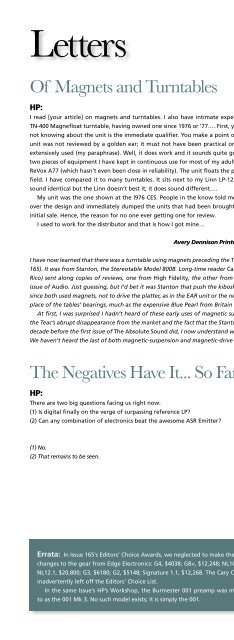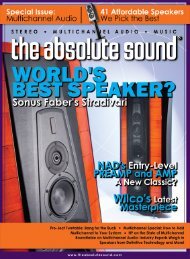Create successful ePaper yourself
Turn your PDF publications into a flip-book with our unique Google optimized e-Paper software.
Letters<br />
Of Magnets and Turntables<br />
HP:<br />
I read [your article] on magnets and turntables. I also have intimate experience with the Teac<br />
TN-400 Magnefloat turntable, having owned one since 1976 or ’77…. First, your statement about<br />
not knowing about the unit is the immediate qualifier. You make a point of saying because the<br />
unit was not reviewed by a golden ear; it must not have been practical or it would have been<br />
extensively used (my paraphrase). Well, it does work and it sounds quite good. It is only one of<br />
two pieces of equipment I have kept in continuous use for most of my adult life; the other is my<br />
ReVox A77 (which hasn’t even been close in reliability). The unit floats the platter on a magnetic<br />
field. I have compared it to many turntables. It sits next to my Linn LP-12.The two units don’t<br />
sound identical but the Linn doesn’t best it; it does sound different….<br />
My unit was the one shown at the l976 CES. People in the know told me that Teac was sued<br />
over the design and immediately dumped the units that had been brought into the market for<br />
initial sale. Hence, the reason for no one ever getting one for review.<br />
I used to work for the distributor and that is how I got mine…<br />
Dan L. Williams<br />
Avery Dennison Printer Systems Americas<br />
I have now learned that there was a turntable using magnets preceding the Teac (see Letters, Issue<br />
165). It was from Stanton, the Stereotable Model 800B. Long-time reader Carlos Bauzá (of Puerto<br />
Rico) sent along copies of reviews, one from High Fidelity, the other from the January 1964 (!)<br />
issue of Audio. Just guessing, but I’d bet it was Stanton that push the kibosh on the Teac design,<br />
since both used magnets, not to drive the platter, as in the EAR unit or the new Clearaudio, but in<br />
place of the tables’ bearings, much as the expensive Blue Pearl from Britain does.<br />
At first, I was surprised I hadn’t heard of these early uses of magnetic suspensions, but given<br />
the Teac’s abrupt disappearance from the market and the fact that the Stanton came out almost a<br />
decade before the first issue of The Absolute Sound did, I now understand why. I can tell you this:<br />
We haven’t heard the last of both magnetic-suspension and magnetic-drive systems<br />
The Negatives Have It... So Far<br />
HP:<br />
There are two big questions facing us right now:<br />
(1) Is digital finally on the verge of surpassing reference LP<br />
(2) Can any combination of electronics beat the awesome ASR Emitter<br />
John Harnick<br />
(1) No.<br />
(2) That remains to be seen.<br />
Errata: In Issue 165’s Editors’ Choice Awards, we neglected to make the following price<br />
changes to the gear from Edge Electronics: G4, $4038; G8+, $12,248; NL10.1, $15,188;<br />
NL12.1, $20,800; G3, $6180; G2, $5148; Signature 1.1, $12,268. The Cary CD 306 was<br />
inadvertently left off the Editors’ Choice List.<br />
In the same Issue’s HP’s Workshop, the Burmester 001 preamp was mistakenly referred<br />
to as the 001 Mk 3. No such model exists; it is simply the 001.<br />
December 2006 The Absolute Sound 13










